ISSN ONLINE(2278-8875) PRINT (2320-3765)
ISSN ONLINE(2278-8875) PRINT (2320-3765)
AnkurDave1 and Shweta Singh2
|
| Related article at Pubmed, Scholar Google |
Visit for more related articles at International Journal of Advanced Research in Electrical, Electronics and Instrumentation Engineering
Networking is always motivated in direction of betterment in communication system. Versatile way i.e. Wireless Sensor Network, Ad-Hoc networks, Mobile Networks, Wired Networks, Local Area Network, Metropolitan Area Network, Wireless Area Network etc., are available but today more emphasize is laid upon achieving an “Energy Efficient Environment”. This paper mainly focuses upon achieving energy efficiency in terms of scheduling with the help of “Polling Scheme”. Basic approach of polling scheme leads us towards utilizing a heterogeneous environment and further leading us to clustering. Here the cluster head governs the whole communication. Besides this “Sleep And Wakeup” phenomena and “Three Way Handshaking” leads us to a collision free and a fully energy efficient system. At last the scheme adapts the “Shortest Path Routing” leads to an optimal environment.
Keywords |
| Wireless Sensor Network, Energy Efficiency, Clustering, Cluster Head, Polling Scheme, Energy Cost, Depth,request to send, clear to send, Sleep and Wake up Scheduling Algorithm, Dynamic Sensor Network and Three way Handshaking. |
INTRODUCTION |
| A wireless sensor network (WSN) is a wireless network consisting of spatially distributed autonomous devices using sensors to cooperatively monitor physical conditions, such as temperature, pressure, sound, pollutants etc., at different locations. Basically it is sub categorized under “Adhoc Networks”. |
A. History |
| The origin of WSNs begin with US military with the first wireless network that bore any resemblance to a modern WSN is SOUN Surveillance System (SOSUS) in the year 1950s to detect the track of Soviet system submarines. Their submerged acoustic sensors where distributed in Atlantic & Pacific oceans , which are still working today but now deployed for underwater wildlife serving and detecting volcanic activity leading to a peaceful approach. |
| In the beginning of 1960s & 1970s with development of today’s Internet , United State started DARPA – Defense Advanced Research Projects Agency deployed first DSN – Distributed Sensor Network in 1980. |
B. Applications |
| Versatile uses of WSNs are applied today leaving the past or initial uses of WSNs. Now it is used in industrial and civilian applications, industrial process monitoring and controlling, health care, health monitoring, instrumentation managements in laboratory and industries, environment detection, habitat monitoring, house-old appliances (smart home), traffic monitoring and controlling etc. |
| Also WSN is today well used in carbon-dating of environment. Nuclear reactor control, fire detection and geographical monitoring, space technologies are its widest applications. |
C. Components |
| Microcontroller: It performs task, process data and controls & monitors the nodes/motes across WSN. |
| Trans-receiver:Its function is sending and receiving the signals across WSN basically known as antenna. |
| Memory unit:It may be on-board or flash memory, depending upon deployment. It possesses all the data and may buffer data in some cases. |
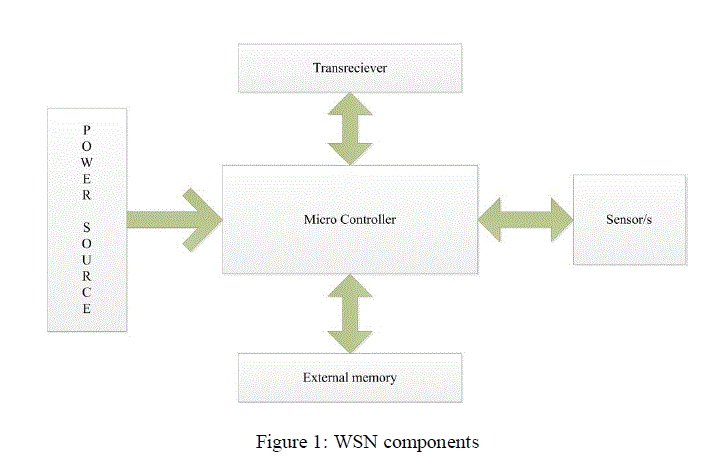 |
RELATED WORK |
| Various researches for energy efficient WSNs are being carried out. The WSN scenario is developed in a way where each node works with their own power bank, yet communicating with each other in field where they are deployed. |
| Other aspect of achieving energy efficiency is improvement of power bank. Improving chemical compositions that are being utilized may lead to a more energy efficiency in WSN. But it won’t lead us to a energy efficient WSN on each transactional level in terms of scheduling. |
| Basically the sensor networking environment is classified in two different ways: |
| A. Homogenous B. Heterogeneous |
| Under the homogenous environment the nodes with similar type of quality and communicating power are classified under this category. This environment was traditionally popular because only a single type of sensor or even a single sensor where utilized in those scenarios. But in today`s world with increasing popularity of WSNs the evolution of heterogeneous technologies is necessary. Thus heterogeneous WSNs play a vital role in the advancement of wireless sensor network technologies. Two main or popular heterogeneous technologies are briefed below: |
A. LEACH: |
| LEACH is the first network protocol that uses hierarchical routing for WSN to increase the life time of network. All nodes are organized into clusters and a node which is taken as clustering criteria is chosen as cluster head. It governs whole communication. In LEACH cluster head positions are randomized among similar type of sensors avoiding draining battery. Then depending upon TDMA inter node communication is being carried out. |
B. S-MAC: |
| The SMAC protocol characterizes each node in terms of individual unique id. Now from the id of each node the weights of each node is calculate and the one with minimum path is select. Besides this the sleep and wake up protocol is used in SMAC to only wake up the current node and keep all the other nodes in sleeping state only. This leads into an energy efficient network. |
PROPOSE MODEL |
A. Cluster Partitioning |
| Cluster is a very well-mannered approach of distributing the nodes across the field. The cluster formation is done mainly in at most two layers; where the upper layer is consisting of parent node, and the bottom layer comprises of end nodes. The scenario may exist with multiple intermediate layers giving rise to a multi-hop environment. |
| Here polling emphasizes upon deploying cluster head with high power transmission only on cluster heads. All these situations provide collision free polling in multi-hop cluster and reduces its energy consumption in ideal listening time. |
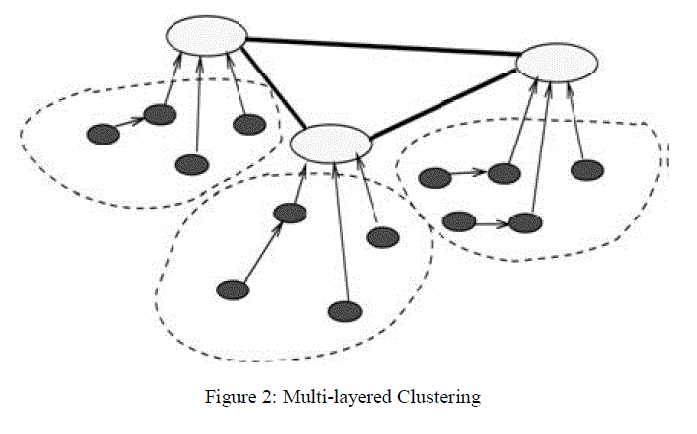 |
B. Deployment |
| The proposed phenomena of polling scheme is completely based upon heterogeneous environment where deployment of nodes is done in similar manner to that of the homogenous environment ; but while achieving randomization in terms of deployment of other cluster head nodes one has to take a great care. Though it would be quite easy in terms of selecting location of cluster head in heterogeneous environment because the no of cluster heads will be surely in less number in comparison to other nodes. |
| The power consumption of data transmission from node-to-node and node-to-cluster head is already studied. To study the power consumption various data structures can be applied. Previously the power calculation was done in tree structure but it would be infeasible in a multi-hop environment to apply the basic tree structure because at every instance of time the structure me change and data forwarding may result into some different kind of structures. |
| The other techniques or aspects of focus are scheduling followed by routing in consecutive fashion. So the whole of the scenario can be module into few processes, and they are: |
| A) Achieving heterogeneous environment by multi-hopping. |
| B) Clustering. |
| C) Deployment of actual polling scheme. |
| D) Performance matrices. |
| A) Achieving heterogeneous environment by multi-hopping: |
| The approach leads us to a heterogeneous multi-layered environment where few nodes are deployed as a cluster head and the other one`s are deployed as child or end nodes. The heterogeneous environment is applied in the scheme with a motivation to prolong the battery life time and ideal listening time of the sensor node. |
| Besides this, these cluster heads are placed into the field in such a manner that almost each individual end node is at least covered by one head. The simple thing here is to notice that number of cluster heads will surely be less in comparison to the other number of end nodes. So it becomes a primary requirement to place the cluster head in best possible manner. |
| B) Clustering: |
| From above discussion it`s obvious now that in heterogeneous environment the cluster head governs the communication and all the messages or packets will be transferred to respective end nodes via it only. So the operation carried out on the most prior level where cluster head is located is equally important to those operations carried out on node level. |
| The popular “ID`s based” discovery of nodes is carried out by each cluster head, by announcing or broadcasting the message containing its own ID. And this procedure of announcement is completed within a bounded amount of time because the numbers of heads are comparatively less. |
| Once the process is competed cluster head starts its “Discovery Process” in order to listen the reply from the end nodes who have listened its announcement and can join it`s cluster. |
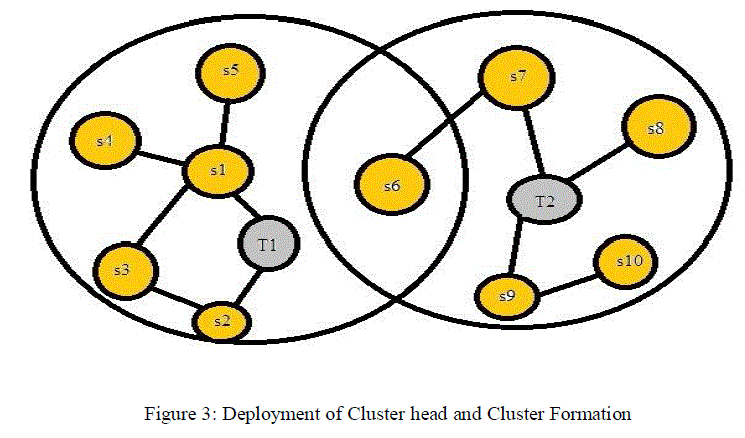 |
| C) Deployment of actual polling scheme: |
| Polling is a scenario with topologies in which one device is designated as a primary station and other devices are secondary stations which we call here as Cluster head and end nodes respectively. All the data exchange must be made through primary device even when ultimate destination is end node. The cluster head controls the link; the end node follows the given instructions. It is all up to the cluster head to determine which node should be allowed to use the channel and at what time. |
| If the cluster head wants to receive the data it asks the secondary if they have anything to send; this is called poll function. If the primary wants to send the data, it tells the secondary to get ready to receive; this is called select function. |
| Both the functions are explained below; more clearly with the help of their sequence diagrams, by taking the example of a single cluster head serving two different end nodes under its own cluster. |
| a) Select: |
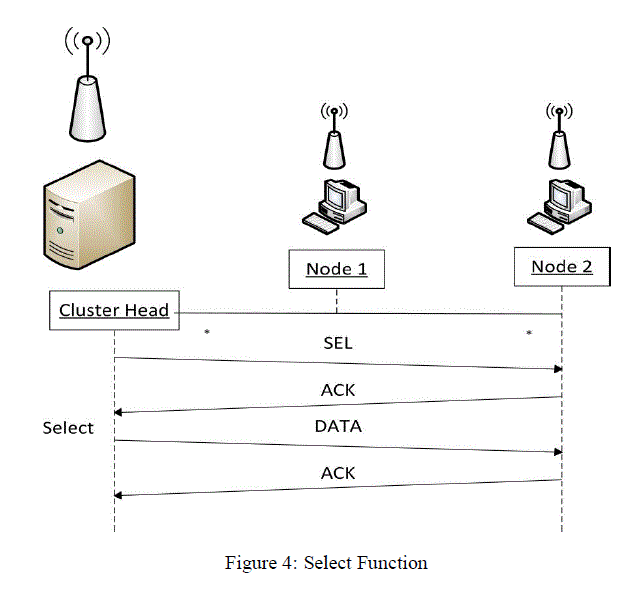 |
| The select function is used whenever the cluster head has something to send. Remember that the cluster head controls the link. If it is neither sending nor receiving data, it knows the link is available. |
| If it has something to send, cluster head sends it. What it does not know, however, is whether the target device is ready to send or not. So the cluster head must alert the end nodes to the upcoming transmission and wait for the acknowledgment of the end node`s ready status. Before sending data, the primary creates and transmits a select (SEL) frame, one field of which includes the address of intended end node. |
| b) Poll: |
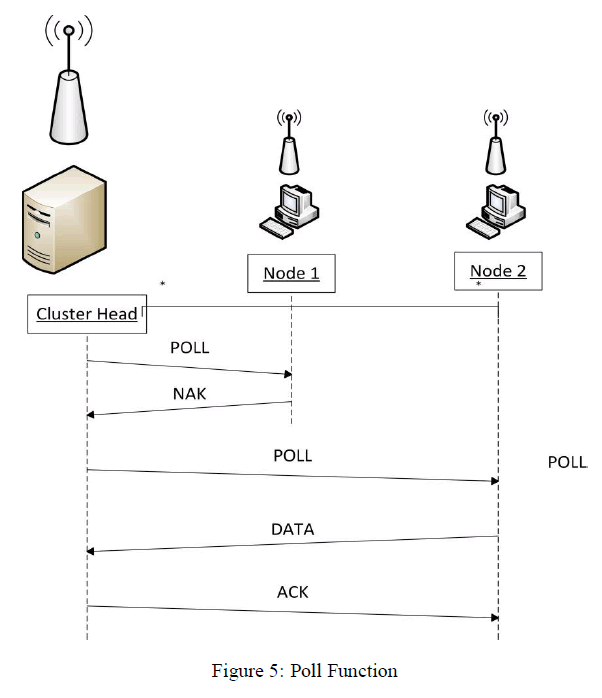 |
| The poll function is used by again the cluster head to solicit transmissions from the secondary devices. When the cluster head is ready to receive the data; it must ask (or one can say poll) each device in turn if it has anything to send. When the first end node is approached, it responds either by NAK frame if it has nothing to send or with a data (in form of frames or packets) if it does. If the response is negative (a NAK frame), then the cluster head polls the end node in same manner until t finds one with a data to send. When the response is positive (a data frame), cluster head reads the frame and returns an acknowledgement (ACK frame), verifying its receipt. |
| D) Performance matrices: |
| a) Effects of dividing field into clusters: |
| By dividing the nodes into clusters, the sensor life time always increase. Besides this in the homogenous scenario, the larger cluster is removed. This may lead to infeasible situation. |
| b) Active time: |
| When we focus upon the active time of each end node, the polling scheme is clearly motivated towards decreasing the active time of nodes. There is a trade-off between listening time and packet loss ratio. If the packet loss ratio is to be decreased then active time of the nodes should be high and if the active time of nodes is less then it will surely result into more packet loss ratio. Thus active time of a node plays a vital role in polling scheme, which is sustainable here. |
| c) Cluster head deployment: |
| With reference to this paper the scenario is considered such where the cluster head are deployed manually on a fixed location, but the actual scenario would be such where more carefully they are deployed and they at least cover one node under each. More emphasize is given to clustering in a manner that all the child or end nodes are covered. |
| d) Message delivery: |
| The message delivery is quite an important aspect. The message relayed by the cluster head will reach to the end node directly because the transmission range as well as power of these nodes is comparatively high. But when the reverse scenario is considered the multi-hop scenario comes into existence. It is clear that heterogeneous environment will surely lead to such a situation. |
| e) BFS: |
| BFS (Breath First Search) technique is applied while the forward and reverse mapping is applied that is communication from one end node to other end node. This results into a better power efficient scenario, which saves more power at each node level. |
| f) Sleep & Wakeup: |
| The polling scheme proposed here leads us to a much more important phenomena, that is of sleep in ideal mode and wake up during actual transmission. The node which is being used for transmission which may be either sender nodes, destination node and intermediate node, will only remain in active state where as the neighboring of current node are remained in suspended state. Thus as a result of this the backtracking can be done in case of failure. So the benefit is that the one path is readily available at any instance of time, this provides us facility to strive against link failure. |
POLLING ALGORITHM |
 |
 |
ADVANTAGES |
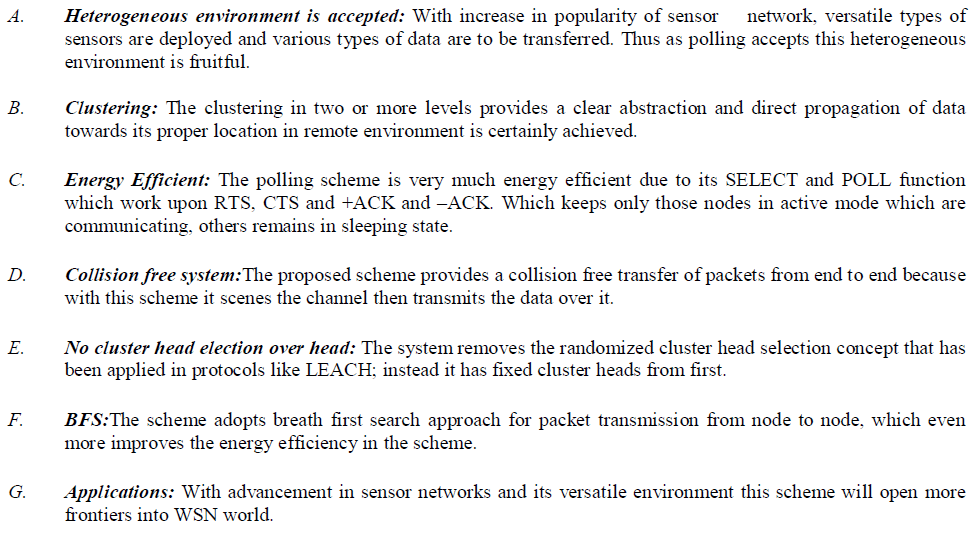 |
CONCLUSION |
| The network is partitioned into clusters and apowerful cluster head controls all sensors in a cluster. The mainfocus is on the energy efficient design within a cluster andto prolong network lifetime. The proposal usedpolling to collect data from sensors instead of letting sensorssend data randomly, so that less energy is consumed. Thesimulation results show that the problem of finding acontention-free polling schedule, which uses the minimumtime, is complex and then gave a fast online algorithm tosolve it approximately. More over collision avoidance is achieved. The simulations can be conducted on theNS-2 simulator. The polling schemeused achieves nearly 100 percent throughput, while reducingthe active time of sensors by a significant amount. Thenetwork lifetime can be further improved by using multiplenonoverlapping frequency channels. When the number offrequency channels keeps on increasing, the percentage ofactive time can always be reduced. |
References |
|